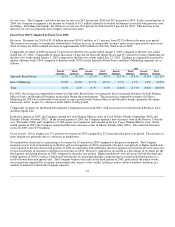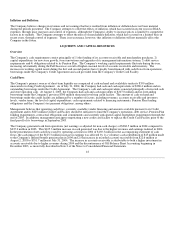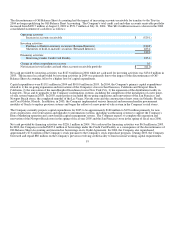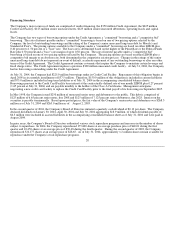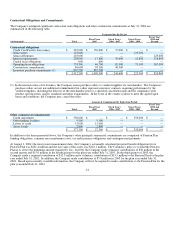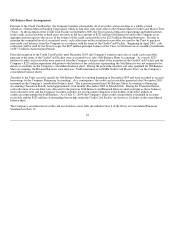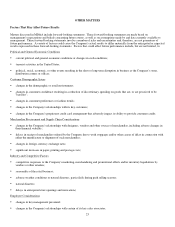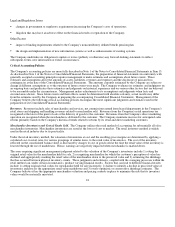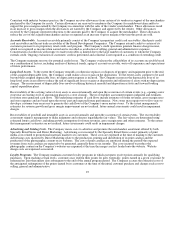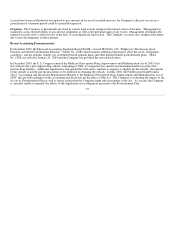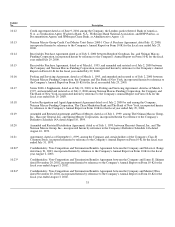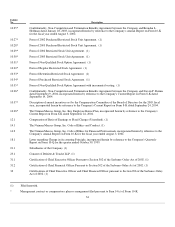Neiman Marcus 2003 Annual Report Download - page 29
Download and view the complete annual report
Please find page 29 of the 2003 Neiman Marcus annual report below. You can navigate through the pages in the report by either clicking on the pages listed below, or by using the keyword search tool below to find specific information within the annual report.
Consistent with industry business practice, the Company receives allowances from certain of its vendors in support of the merchandise
purchased by the Company for resale. Certain allowances are received to reimburse the Company for markdowns taken and/or to
support the gross margins earned by the Company in connection with the sales of the vendor's merchandise. These allowances result
in an increase to gross margin when the allowances are earned by the Company and approved by the vendor. Other allowances
received by the Company represent reductions to the amounts paid by the Company to acquire the merchandise. These allowances
reduce the cost of the acquired merchandise and are recognized as an increase to gross margin at the time the goods are sold.
Accounts Receivable. Accounts receivable primarily consist of the Company's proprietary credit card receivables, third-party credit
card receivables and the net trade receivables of the Brand Development Companies. The Company extends credit to certain of its
customers pursuant to its proprietary retail credit card program. The Company's credit operations generate finance charge income,
which is recognized as income when earned and is recorded as a reduction of selling, general and administrative expenses.
Concentration of credit risk with respect to trade receivables is limited due to the large number of customers to whom the Company
extends credit. Ongoing evaluation of customers' credit is performed and collateral is not required as a condition of extending credit.
The Company maintains reserves for potential credit losses. The Company evaluates the collectibility of its accounts receivable based
on a combination of factors, including analysis of historical trends, aging of accounts receivable, write-off experience and expectations
of future performance.
Long-lived Assets. To the extent the Company remodels or otherwise replaces or disposes of property and equipment prior to the end
of the assigned depreciable lives, the Company could realize a loss or gain on the disposition. To the extent assets continue to be used
beyond their assigned depreciable lives, no depreciation expense is incurred. The Company reassesses the depreciable lives of its
long-lived assets in an effort to reduce the risk of significant losses or gains at disposition and utilization of assets with no depreciation
charges. The reassessment of depreciable lives involves utilizing historical remodel and disposition activity and forward-looking
capital expenditure plans.
Recoverability of the carrying value of store assets is assessed annually and upon the occurrence of certain events (e.g., opening a new
store near an existing store or announcing plans for a store closing). The recoverability assessment requires judgment and estimates
for future store generated cash flows. The underlying estimates of cash flows include estimates of future revenues, gross margin rates
and store expenses and are based upon the stores' past and expected future performance. New stores may require two to five years to
develop a customer base necessary to generate the cash flows of the Company's more mature stores. To the extent management's
estimates for revenue growth and gross margin improvement are not realized, future annual assessments could result in impairment
charges.
Recoverability of goodwill and intangible assets is assessed annually and upon the occurrence of certain events. The recoverability
assessment requires management to make judgments and estimates regarding the fair values. The fair values are determined using
estimated future cash flows, including growth assumptions for future revenues, gross margin rates and other estimates. To the extent
that management's estimates are not realized, future assessments could result in impairment charges.
Advertising and Catalog Costs. The Company incurs costs to advertise and promote the merchandise assortment offered by both
Specialty Retail Stores and Direct Marketing. Advertising costs incurred by the Specialty Retail Stores consist primarily of print
media costs related to promotional materials mailed to its customers. These costs are expensed at the time of mailing to the customer.
Advertising costs incurred by Direct Marketing relate to the production, printing and distribution of its print catalogs and the
production of the photographic content on its websites. The costs of print catalogs are amortized during the periods the expected
revenues from such catalogs are expected to be generated, generally three to six months. The costs incurred to produce the
photographic content on the Company's websites are expensed at the time the images are first loaded onto the website. Website
design costs are expensed as incurred.
Loyalty Programs. The Company maintains customer loyalty programs in which customers receive points annually for qualifying
purchases. Upon reaching certain levels, customers may redeem their points for gifts. Generally, points earned in a given year must be
redeemed no later than ninety days subsequent to the end of the annual program period. The Company accrues the estimated costs of
the anticipated redemptions of the points earned by its customers at the time of the initial customer purchase and charges such costs to
selling, general and administrative
25


